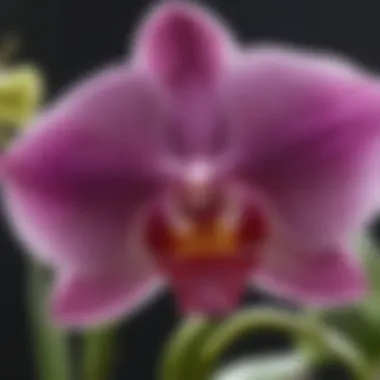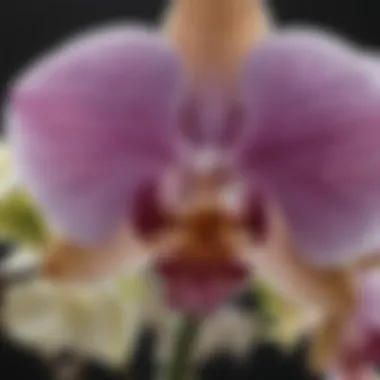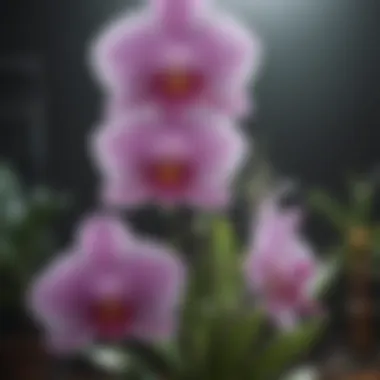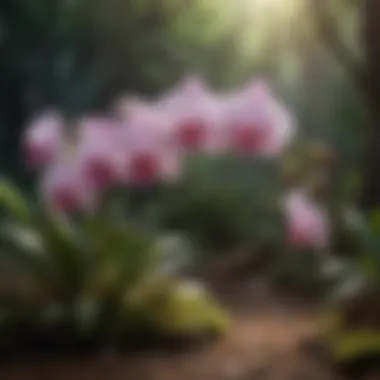An In-Depth Exploration of Unique Orchid Breeds


Intro
Orchids are among the most diverse and fascinating families of flowering plants. Known scientifically as Orchidaceae, they include over 25,000 species and countless hybrids. This article seeks to unlock the secrets of various orchid breeds, diving into their unique attributes, cultivation needs, and ecological importance. The diversity of orchids extends beyond their visual appeal to their role in ecosystems and human culture.
Fascinating Facts About Orchids
Unique Characteristics
Orchids display an array of characteristics that set them apart from other flowering plants. Many species have specialized structure to attract pollinators. The shapes and colors of orchid flowers can be strikingly unique, with some resembling insects or even birds, aiding in their reproduction. The lip or labellum is often an attention-grabbing feature, with its form and coloration evolving to aid pollination.
Extraordinary Abilities
Orchids possess a remarkable adaptability. Some species can thrive in varied environments, from tropical rainforests to arid deserts. Their symbiotic relationships with fungi enable them to absorb nutrients from poor soil, making them resilient plants in challenging conditions. Additionally, certain orchids exhibit unique reproductive strategies, such as self-pollination, allowing them to flourish even in isolation.
Cultivation and Care
Proper cultivation of orchids requires a nuanced understanding of their diverse needs.
- Light: Most orchids flourish with bright, indirect sunlight.
- Water: Overwatering can be detrimental; allowing the medium to dry slightly between waterings is often best.
- Humidity: Orchids thrive in humid environments; misting can help achieve optimal levels.
Monitoring temperature is also crucial. Different species may require specific temperature ranges to induce flowering.
Ecological Significance
Orchids play a crucial role in maintaining the health of their ecosystems. They are often indicators of environmental quality due to their sensitivity to habitat changes. The mutualistic relationships they form with pollinators and fungi not only benefit their growth but also support a variety of other species in their habitats.
By preserving orchid species, we help sustain broader ecological networks that depend on the balance these plants maintain.
“Conservation efforts for orchids are vital, as many species face threats from habitat loss and climate change.”
Hybridization Processes
Hybridization has become a major aspect of orchid cultivation. Breeders often cross different species to create hybrids that possess desirable traits. This can include improved aesthetics, increased resilience to diseases, or enhanced flowering frequency. Understanding the genetics involved in hybridization helps in developing successful breeding programs.
Closure
The exploration of orchid breeds reveals their complex interactions within ecosystems and highlights the significance of these plants in horticulture and conservation. Understanding their unique characteristics and cultivation needs allows enthusiasts to appreciate these remarkable species while contributing to their preservation.
As interest grows in preserving orchid species, a collective effort is necessary. By fostering awareness and implementing conservation strategies, we can ensure that these extraordinary plants continue to thrive in their natural habitats.
Understanding Orchids
Understanding orchids is essential for appreciating their complexity and diversity. This family of plants, known as Orchidaceae, includes an extensive array of species and hybrids, each with unique characteristics and adaptation strategies. The exploration of orchids provides insight into their ecological roles, horticultural practices, and cultural significance, offering a holistic view of these fascinating flowers.
Overview of Orchidaceae Family
The Orchidaceae family consists of over 25,000 species, making it one of the largest plant families worldwide. These plants can be found in nearly every habitat except extreme deserts and polar regions. They exhibit various forms, sizes, and colors, which capture the interest of collectors and botanists alike. The diversity is not just superficial; it extends to their reproductive strategies, some utilizing complex mechanisms to attract specific pollinators. Understanding this family helps in recognizing the interconnections between different orchid species and their ecological dynamics.
Ecological Importance of Orchids
Orchids play a crucial role in their ecosystems. They contribute to biodiversity, serving as both food and habitat for numerous insects and birds. Their intricately designed flowers often attract specialized pollinators, which can be critical for the survival of certain species. Furthermore, orchids participate in symbiotic relationships with fungi, aiding in nutrient acquisition from their environment.
Quote: The loss of orchids in any ecosystem can signify broader environmental issues, as they are often indicators of ecological health.
Orchid Lifecycles and Growth Habits


The lifecycle of an orchid can vary significantly based on species and environmental conditions. Most orchids undergo a series of growth stages, starting from seed germination to mature flowering plants. They may be terrestrial or epiphytic, adapting to their surroundings. Epiphytic orchids grow on trees or other surfaces, drawing moisture and nutrients from the air and rain rather than from soil. In contrast, terrestrial orchids are rooted in the ground. Observing their growth patterns is critical for understanding how to care for and cultivate them effectively.
Major Orchid Breeds
The significance of understanding major orchid breeds lies in the diversity they represent within the Orchidaceae family. Each breed offers distinct characteristics, cultivation needs, and aesthetic qualities. For gardening enthusiasts, botanists, and furniture of floral beauty, knowing these breeds enhances their appreciation and care for orchids. The information on major orchid breeds serves as a guide to their growing conditions, visual appeal, and ecological contributions.
Phalaenopsis Orchids
Phalaenopsis orchids, commonly known as moth orchids, are renowned for their wide, flat blooms and long-lasting flowers. They are popular in both the commercial orchid market and among hobbyists due to their relatively easy care requirements. These orchids thrive in warm temperatures and moderate light, making them suitable for indoor cultivation.
Characteristics of Phalaenopsis orchids include:
- Flower colors: They come in various colors, including white, pink, and yellow.
- Growth habit: Their upright leaves and long flower spikes provide an elegant appearance.
- Blooming period: They can bloom several times a year with proper care.
Phalaenopsis orchids are excellent choices for beginners and can adapt well to different growing conditions if the humidity and light are managed properly.
Cattleya Orchids
Cattleya orchids are known for their large, fragrant flowers and are often called the 'queen of orchids'. These orchids are a favorite for creating stunning floral arrangements. Cattleyas typically require bright, indirect light and well-drained potting media. They are less tolerant of over-watering, making their care somewhat more challenging than Phalaenopsis orchids.
Key features of Cattleya orchids include:
- Fragrance: Many varieties produce a sweet scent, adding to their allure.
- Color variety: Their blooms can possess a range from vibrant purples to soft pastels.
- Growth structure: Cattleyas have pseudobulbs that store moisture, allowing them to thrive in varying conditions.
Cultivating Cattleya orchids requires careful attention to watering and light exposure to coax their spectacular blooms.
Dendrobium Orchids
Dendrobium orchids are varied and numerous, comprising over 1,800 species. Their adaptability makes them popular among collectors. They require conditions ranging from cool to warm environments, depending on the species.
Notable aspects of Dendrobium orchids are:
- Species diversity: Some species prefer high humidity, while others are more drought tolerant.
- Growing forms: They may grow in a variety of shapes, from upright to cascading.
- Flowering habits: Many species can bloom repeatedly throughout the year.
Dendrobiums can be rewarding to grow, but understanding the specific species' requirements is crucial for successful cultivation.
Vanda Orchids
Vanda orchids stand out for their striking, often large blooms that are highly prized in the floral industry. They are typically epiphytic and thrive when mounted on wood or placed in baskets. Vanda orchids prefer high light levels, warm temperatures, and good air circulation.
Essential characteristics include:
- Colorful blooms: Tattoos of hues and patterns adorn their large petals.
- Growth needs: They require consistent watering and humidity to maintain health.
- Foliage: Their leaves are thick, helping them store moisture effectively.
These orchids can be challenging for new growers but are valued for their beauty when well cared for.
Oncidium Orchids
Oncidium orchids, often referred to as dancing ladies, feature many small flowers on a single stem. These orchids are well-known for their unique flower shapes and bright colors. They are generally easy to care for and thrive in moderate light and humidity.
Distinct features of Oncidium orchids include:
- Multiple blooms: A single spike can carry numerous flowers.
- Visual appeal: Their vibrant yellow and brown varieties are quite popular.
- Growth preference: They tend to prefer intermediate temperatures.
Oncidiums are an excellent addition to any orchid collection, particularly for those seeking visually engaging blooms.
Paphiopedilum Orchids


Paphiopedilum orchids, commonly recognized as lady slipper orchids, feature unique pouch-like flowers. They are terrestrial orchids, which means they grow in the ground rather than as epiphytes. These orchids require specific care, including consistent moisture and shade.
Main characteristics include:
- Shape: The distinctive slipper-shaped blooms add interest.
- Light requirements: They thrive in dim light conditions.
- Variety: Many hybrids exist, offering a wide range of appearances.
Paphiopedilum orchids can be rewarding for those willing to pay close attention to their needs, allowing them to thrive in a domestic setting.
Factors Influencing Orchid Cultivation
When it comes to cultivating orchids, understanding the various factors that influence their growth is crucial. Each orchid type has unique requirements that must be met for optimal survival and flourishing. Failing to appreciate the nuances of these conditions can lead to disappointing outcomes or loss of plants altogether. The interplay between environmental and care factors shapes the health and vitality of orchids, making this knowledge essential for both the novice and experienced grower.
Climate Requirements
Orchids are diverse. They thrive in different climates, often found in tropical to temperate zones. The climate can significantly affect their growth, flowering, and overall health. For example, Phalaenopsis orchids prefer warm conditions, typically between 70 to 85°F during the day and slightly cooler at night. In contrast, some Dendrobium species can tolerate cooler nighttime temperatures.
Humidity is another aspect of climate. Most orchids need humidity levels between 40-70%. A dry environment can stress the plants, leading to issues like leaf drop or poor flowering. Growing orchids in a greenhouse or using humidity trays will help in maintaining adequate moisture in the air.
Soil and Potting Mixes
Selecting the right soil is fundamental for orchid health. Traditional potting soils retain too much moisture, which can cause root rot. Instead, orchids thrive in specialized mixes that promote drainage and aeration. Common components of orchid potting mixes include bark chips, coconut husks, or perlite.
It is essential to choose a mix that suits the specific breed of orchid. For example, Vanda orchids do well in a coarse medium because they prefer to dry out completely. In contrast, Paphiopedilum orchids may favor a more moisture-retentive mixture due to their natural habitats.
Watering and Humidity Needs
Watering an orchid can be intricate. It is vital to adapt the watering routine to the plant's environment and the season. Overwatering often leads to the most significant problems. Many orchids prefer to dry out slightly between waterings. Techniques like the “soak and dry” method can be effective—soaking the roots and allowing them to dry out can mimic natural conditions.
Humidity plays a crucial role as well. Not only does it support transpiration, but it also helps to maintain healthy root systems. Using a hygrometer to measure indoor humidity can assist growers in delivering the ideal moisture level. Misting plants occasionally can create a more favorable microclimate around the orchid.
Light Exposure
Light is another key factor in orchid cultivation. Different species of orchids have varied light needs. Phalaenopsis orchids thrive in bright, indirect sunlight. Conversely, Vanda orchids require more direct light to flourish. Striking the right balance in light exposure can dictate the plant's ability to photosynthesize effectively, impacting overall health and flowering potential.
Monitoring the orchid's response to light is essential. Leaf yellowing may indicate too much light, while dark green leaves can signify insufficient light. Employing sheer curtains for diffused light can be a common strategy for indoor orchid cultivation, allowing adequate light while reducing the risk of scorching.
Understanding these factors not only enhances the growth of orchids but also enriches the cultivator's experience.
By addressing climate, soil, watering, and light needs, growers can create a more favorable environment for their orchids. This careful consideration is vital for successfully enjoying these captivating plants, making them a rewarding addition to any home or garden.
Hybridization of Orchids
Hybridization plays a pivotal role in the realm of orchids. It serves as a conduit for increased diversity and innovation within this family of plants. In the context of this article, exploring hybridization provides insights into the complex interplay between botanical science and horticultural practices. It enables cultivators to develop new breeds that may exhibit improved traits such as enhanced coloration, resilient growth habits, and increased blooming frequency. The process also allows for the preservation of unique genetic materials, contributing to the stability and sustainability of orchid populations in both cultivation and wild settings.
Understanding Hybridization
Hybridization refers to the process of crossbreeding two distinct orchid species or varieties to produce hybrid offspring. This practice harnesses diverse genetic traits that exist within different species, resulting in flowers that can possess characteristics from both parents. The process requires careful consideration, including understanding the compatibility of species, fertility potential, and the desired outcomes of crossbreeding. One key aspect is that hybrids often outperform their parent species in certain traits, which can make these plants more appealing to both hobbyist growers and commercial cultivators.
Popular Hybrid Orchid Breeds
Several hybrid orchid breeds have garnered attention due to their remarkable qualities, which include:
- Phalaenopsis hybrids: Known for their long-lasting blooms and ease of care, these hybrids are frequent choices for indoor growers.
- Cattleya hybrids: Renowned for their large, vibrant flowers, they often exhibit a delightful fragrance that appeals to many collectors.
- Dendrobium hybrids: Versatile and adaptive, they thrive in various environments and display a wide color range.
- Oncidium hybrids: Often referred to as
Cultural Significance of Orchids


The cultural significance of orchids extends far beyond their beauty. These flowers play an essential role in various societies, often symbolizing traits like love, luxury, and strength. On a deeper level, orchids' unique characteristics have captured human fascination for centuries, influencing art, literature, and traditional practices across the globe. In this context, orchids serve not only as decorative elements but also as cultural icons intertwined with the values and histories of people.
Historical Context
Throughout history, orchids have held a prestigious position in human culture. In ancient Greece, they were associated with fertility and considered a symbol of virility. The name 'orchid' itself stems from the Greek word 'orchis', which means testicle, due to the shape of their tuber. During the Victorian era, orchids were highly sought after by the wealthy and were even considered a status symbol. Cultivating rare orchid species became a lavish hobby, leading to significant exploration and trade.
Over time, some species became endangered due to over-collection. This highlighted the need for conservation and sustainable practices, reflecting the changing attitudes towards nature and preservation. Today, these flowers are not just admired as luxury items but appreciated for their ecological role and the need to protect their natural habitat.
Orchids in Different Cultures
Various cultures celebrate orchids in distinctive ways, each with its own meaning attached to them. For example, in China, orchids symbolize refinement, luxury, and integrity. They are often gifted on special occasions, representing good fortune and wealth.
In contrast, Japanese culture regards orchids as a representation of beauty and elegance, often incorporated into art and poetry. The Phalaenopsis orchids, popular in the West, are given as gifts during significant celebrations, including weddings, to symbolize love and beauty.
In some Southeast Asian cultures, orchids like the Vanda are associated with festivals and rituals, reflecting closeness to nature. Among the Maori in New Zealand, orchids are part of traditional healing practices, demonstrating their importance beyond aesthetic value.
Key Points on Cultural Significance:
- Status Symbol: In history, orchids symbolized luxury and were a mark of wealth.
- Cultural Identity: Different regions place various meanings on orchids, linking them to local customs.
- Art and Literature: Orchids have inspired numerous artistic expressions, contributing to cultural heritage.
- Conservation Awareness: Increased awareness of endangered species fosters respect for nature and biodiversity.
Orchids serve as more than just flora; they are vessels of cultural significance, entrenching values and histories in their delicate petals.
In this manner, orchids represent a rich tapestry of human emotion and belief, fostering an appreciation that is every bit as complex as the flowers themselves.
Conservation Efforts for Orchids
Orchids are not just admired for their beauty but also face numerous threats leading to decreased populations in their natural habitats. Conservation efforts are vital to preserving these unique species, their ecosystems, and the biodiversity they contribute to. This section covers important aspects of why conservation is critical for orchids and outlines the specific threats they face, along with strategies to combat these challenges.
Threats to Orchid Populations
Orchids confront a variety of threats that put their existence at risk. These threats can be broadly categorized into environmental, economic, and social factors:
- Habitat Loss: Urbanization and agricultural expansion lead to the destruction of habitats where orchids thrive. Deforestation is particularly devastating in tropical areas, where many endemic species exist.
- Climate Change: As temperatures rise and weather patterns shift, orchids may struggle to adapt to new conditions. Changes in rainfall patterns can affect their natural growth cycles and survival rates.
- Illegal Trade: The demand for rare orchid species in both horticulture and perfumery has fueled illegal harvesting. Plants are often removed from their native habitats, disrupting local ecosystems.
- Pollinator Decline: Many orchids depend on specific pollinators for reproduction. The decline in bee populations and other pollinators directly threatens the ability of orchids to reproduce successfully.
“The intricate relationships between orchids and their pollinators underscore the fragility of these plants and the ecosystems they inhabit.”
These threats illustrate the need for diligent conservation efforts to protect the remaining natural habitats and the orchids that depend on them.
Conservation Strategies
Preserving orchid populations requires multifaceted approaches. Conservation strategies can be divided into proactive and reactive measures:
- Establishment of Protected Areas: Creating reserves ensures that orchids grow in safe environments, shielded from urban development and agricultural activities. These protected areas can maintain the specific conditions that these species require.
- Legislation and Regulation: Implementing strict regulations against illegal orchid trade can deter poaching. Organizations and governments must work together to enforce laws that protect threatened species.
- Education and Community Involvement: Engaging local communities in conservation efforts fosters awareness about the significance of orchids. Educational programs can highlight the ecological and economic value of preserving local flora.
- Research and Monitoring: Continuous research is essential to understand the specific needs of different orchid species and monitor their population dynamics. Data collected can inform better conservation practices.
- Propagation and Restoration: Cultivating orchids in controlled environments and reintroducing them to their natural habitats can help recover declining populations. This method ensures that genetic diversity is maintained.
Future of Orchid Breeding and Conservation
The future of orchid breeding and conservation is a critical area of study as it encapsulates the ongoing challenges and exciting possibilities in preserving these remarkable plants. As orchid species continue to face threats from habitat loss, climate change, and over-collection, the efforts in breeding and conservation become more pressing. This section will analyze innovative breeding techniques and the impact of technology on these conservation efforts.
Innovations in Breeding Techniques
Recent advancements in breeding techniques have revolutionized how orchids are cultivated. These methods allow hybridizers to produce orchids with desirable traits, while also promoting genetic diversity among species. Some key innovations include:
- Tissue Culture: This technique enables large-scale propagation of orchids. By culturing plant cells in artificial media, growers can produce healthy plants quickly and efficiently.
- Genetic Engineering: This area is becoming more prominent. Researchers explore manipulating genes to create orchids that are more resilient to pests and diseases or have improved aesthetic qualities.
- Cross-Breeding: Traditional hybridization is still a vital method. Breeders are combining different species to create unique forms and colors that can appeal to a broader market.
Each of these methods not only aims to produce beautiful orchids but also focuses on maintaining or enhancing the genetic pool, which is crucial for the long-term survival of these species in changing environments.
The Role of Technology in Conservation
Technology plays a significant role in conservation strategies for orchids. Various modern technologies provide tools that help in monitoring and protecting orchid habitats effectively. Some of these include:
- Remote Sensing: Utilizing satellite images to monitor orchid habitats and assess how they are impacted by environmental changes.
- Data Analysis: Big data techniques help researchers analyze large datasets regarding orchid populations and their habitats. This can highlight trends and inform conservation strategies.
- Mobile Applications: Citizen science initiatives leverage mobile apps for identification and reporting of orchid sightings. This empowers the public to participate actively in conservation.
With the integration of technology in orchid conservation, there is hope for holistic approaches that can sustain orchid populations in their natural habitats.







